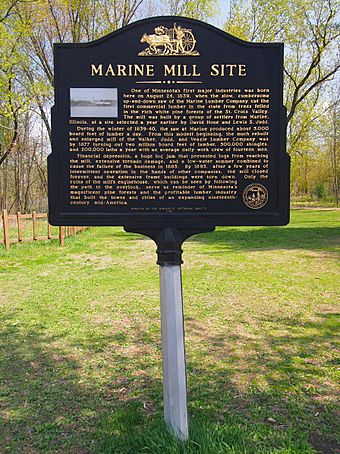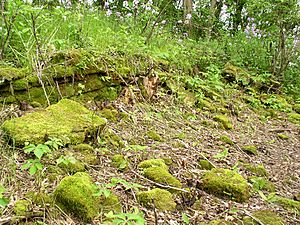Marine Mill facts for kids
|
Marine Mill Site
|
|
|
U.S. Historic district
Contributing property |
|

The Marine Mill Site historical marker
|
|
| Location | Judd Street, Marine on St. Croix, Minnesota |
|---|---|
| Area | 7 acres (2.8 ha) |
| Built | 1839–1873 |
| Part of | Marine on St. Croix Historic District (ID74001043) |
| MPS | Washington County MRA (AD) |
| NRHP reference No. | 70000311 |
Quick facts for kids Significant dates |
|
| Added to NRHP | January 26, 1970 |
| Designated CP | June 28, 1974 |
The Marine Mill was a very important sawmill built way back in 1839. It was the very first commercial sawmill in what we now call the state of Minnesota! Even though it's mostly ruins today, it's a special historic site. The city of Marine on St. Croix and the Minnesota Historical Society work together to take care of it. This site is listed on the National Register of Historic Places because it was so important for starting the lumber industry in this area. It was also a key stop on the St. Croix River, which was like a highway for moving logs and goods. The mill site is also part of the larger Marine on St. Croix Historic District.
Contents
The Marine Mill Story
Building the First Mill
In 1838, two men named Lewis Judd and David Hone were exploring the area. They found a perfect spot for a sawmill: a fast-flowing stream for power and a riverbank where steamboats could easily dock. They were part of a group from New England who had traveled west looking for new places to cut lumber.
They went back to their home base in Marine, Illinois, and started a company called the Marine Lumber Company. Eight partners, along with one partner's wife and two children, arrived by steamboat in May 1839. They brought all the machinery needed for the mill. In just 90 days, they finished building their sawmill! They cut their first lumber on August 24, 1839. This land had only been bought by the United States from the Ojibwe and Dakota people in 1837, so it wasn't even officially open for people to settle yet.
How the Mill Grew and Changed
The first mill was quite small. It could cut less than 5,000 feet (1,500 m) of lumber each day. So, in 1852, they replaced it with a much bigger mill. This new mill was powered by a huge 40-foot (12 m) water wheel.
However, disaster struck in September 1863 when the entire building burned down. This meant workers couldn't do their jobs for three years. A new mill was finally built in 1866. To keep up with other lumber companies, this mill was almost completely rebuilt in 1873. After this upgrade, it could cut an amazing 30,000 feet (9,100 m) of lumber every day!
The Mill's Final Years
In the early 1870s, the mill was doing very well. It was known as the Walker, Judd, and Veazie Mill then. But soon, things got tough. A big economic downturn, called the Panic of 1873, hit the country. There were also many delays because of log jams on the river. Plus, the supply of trees in the valley was running out.
Because of these problems, the mill went out of business in 1885. People tried to reopen it, but nothing worked. The business was finally taken apart in 1895. Over its 56 years of operation, the Marine Mill produced about 197,000,000 feet (60,000,000 m) of lumber! That's a lot of wood!
Saving the Historic Site
After the mill closed, the site was left abandoned for almost 70 years. Then, in 1964, a group suggested that the land should be bought and turned into a historic site. Nothing happened right away, but in 1970, a local committee formed to push for its preservation.
The next year, the Minnesota Legislature set aside money to buy the site. The local committee also worked hard to clear away decades of overgrown plants, which helped them find the old foundations of the mill buildings. The land was officially bought in 1972 and given to the Minnesota Historical Society to care for.
What You See Today
When the mill was at its busiest, the whole complex covered about six acres (2.4 ha). Besides the main sawmill, there was a planing mill, storage sheds, a steamboat dock, and huge piles of cut lumber, shingles, and laths (thin strips of wood).
Between 1888 and 1895, all the wooden buildings were taken down, and the machinery was sold. All that was left were the stone walls of the 1873 sawmill and its water wheel. Today, you can see a historical marker at the entrance to the property. An open grassy area leads to a spot where you can look down at the sawmill ruins. There's also a short trail that takes you past the faint outlines of where two other mill buildings once stood. The same stream that powered the mill still flows through the site today.




